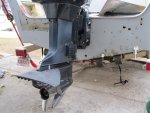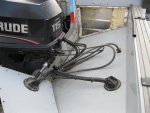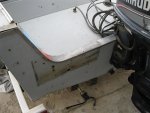After doing a bit of research and looking for info, I finally tore into my 92 Sea Nymph SS 175. The transom had gotten extremely soft, needed to be replaced. There wasn't much info out there, but everything so far has been pretty simple. Hoping this info can help someone else down the road.
My boat has an Evinrude 115 and plate for a 8 hp Nissan 4s kicker on the port side. You could really see the softness of the transom in the area of the kicker plate. The plate is through bolted into the transom with several bolts. Little evidence of sealing the bolt holes or around the bolts was evident.
The kicker and plate were pulled off. The main motor lifted off pretty easily as well. The biggest trouble so far was removing the bolts that thru bolted through the transom. Some of the bolts were accessible through the bilge area. The other bolts were buried in the floation compartments on either side of the bilge and below the splashwell. THe simplest way to access was to remove the side panels of the splashwell. The hollow areas below were filled completely with foam. About 5 hours later I had enough foam out to get to the bolts. The transom cap as well as the end caps were all easily removed.
Damage to the transom was worse than expected. About half of it came out as wet wood chips, the other half was just solid enough to get out in one piece.
Currently I have the new transom laminated and am getting ready to pattern. Need some decent weather to get it resin coated after I get it patterned. Will update with more pics as I go.
My boat has an Evinrude 115 and plate for a 8 hp Nissan 4s kicker on the port side. You could really see the softness of the transom in the area of the kicker plate. The plate is through bolted into the transom with several bolts. Little evidence of sealing the bolt holes or around the bolts was evident.
The kicker and plate were pulled off. The main motor lifted off pretty easily as well. The biggest trouble so far was removing the bolts that thru bolted through the transom. Some of the bolts were accessible through the bilge area. The other bolts were buried in the floation compartments on either side of the bilge and below the splashwell. THe simplest way to access was to remove the side panels of the splashwell. The hollow areas below were filled completely with foam. About 5 hours later I had enough foam out to get to the bolts. The transom cap as well as the end caps were all easily removed.
Damage to the transom was worse than expected. About half of it came out as wet wood chips, the other half was just solid enough to get out in one piece.
Currently I have the new transom laminated and am getting ready to pattern. Need some decent weather to get it resin coated after I get it patterned. Will update with more pics as I go.






















